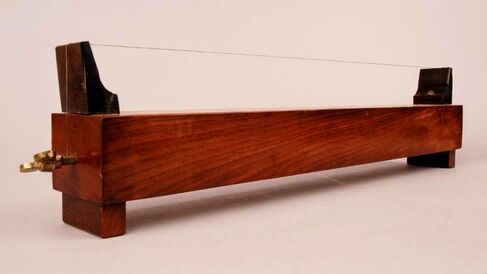Monochord

The monochord is an ancient scientific and musical instrument, invented in Greece in c. 500 BC, used for the investigation and demonstration of musical phenomena. The Whipple Museum's collection includes a 19th-century example from the Wheatstone laboratory, King's College London.
Join the University of Cambridge Museums to enjoy hands-on activities inspired by the collections. Plus pick up an action-packed Summer at the Museums programme for families. We'll be there making models of different celestial movements - looking at eclipses, transits and orbits!
Free, drop in. Ages 4+
Location: Parker's Piece
We're joining the Sedgwick Museum to explore different types of brain and how we understand them. Have a closer look and make your own thinking cap and model brain.
Free, drop in. Age 5+.
Location: Sedgwick Museum
Description
The monochord consists of a metal string stretched over a hollow resonating body. Using a movable bridge the string can be divided into two portions whose lengths may be set at any ratio to give various pitches and musical intervals when plucked. According to tradition, the ancient Greek philosopher Pythagoras (fl. 4th century BC) discovered the correspondence between simple ratios of string length and consonant musical intervals. Dividing the string into sections in the ratios 2:1 or 3:2, for example, yields the intervals of a perfect octave and perfect fifth respectively.
Pythagoras and his followers believed that the whole universe could be understood in terms of musical harmonies and simple mathematical ratios. Until at least the 17th century astronomers such as Johannes Kepler (1571-1630) believed that the planets moved in such a way as to produce a kind of cosmic harmony. Astronomy and the study of musical harmonythus went hand in hand and music was considered a proper part of science throughout the medieval and into the early modern period.
Musical uses
The monochord was used as a musical teaching tool in the 11th century by Guido of Arezzo (c. 990-1050), the musician who invented the first useful form of musical notation. By laying out the notes of a scale on a monochord, he was able to teach choir boys how to sing chant and also to detect incorrect chanting. A monochord-like instrument called the Tromba Marina was used for practical music making between the 15th and 18th centuries. The monochord was also used for tuning instruments and was still in use in the 19th century for tuning organs. More commonly, the monochord was, and still is, used for demonstration purposes.
The Whipple also owns a similar device, that we call the 'duochord'. This instrument was built by the Cambridge instrument maker Martin Woodhouse. Commissioned in 2008, it is in use for demonstration purposes and as an interactive exhibit.
Torben Rees
Torben Rees, 'Monochord: an ancient musical and scientific instrument', Explore Whipple Collections, Whipple Museum of the History of Science, University of Cambridge, 2009
